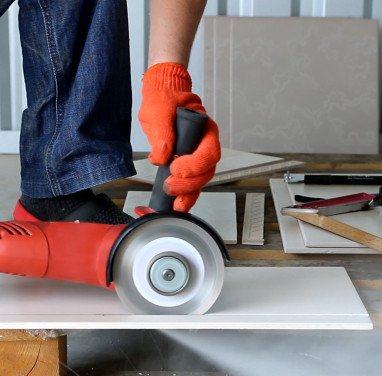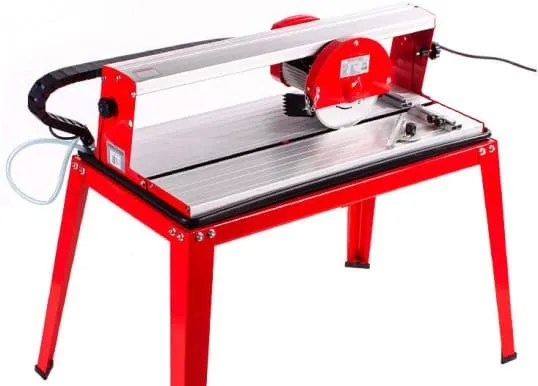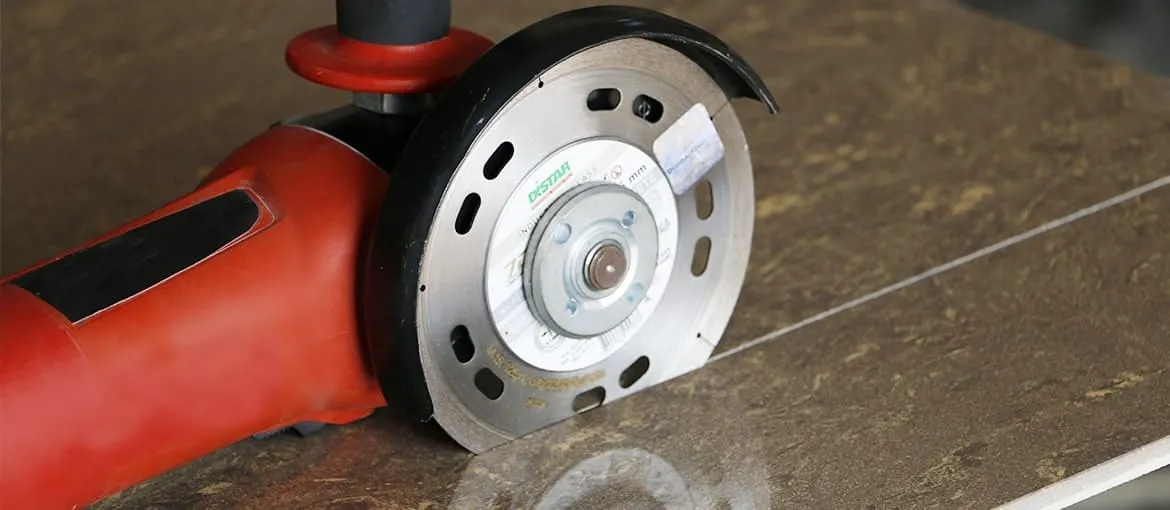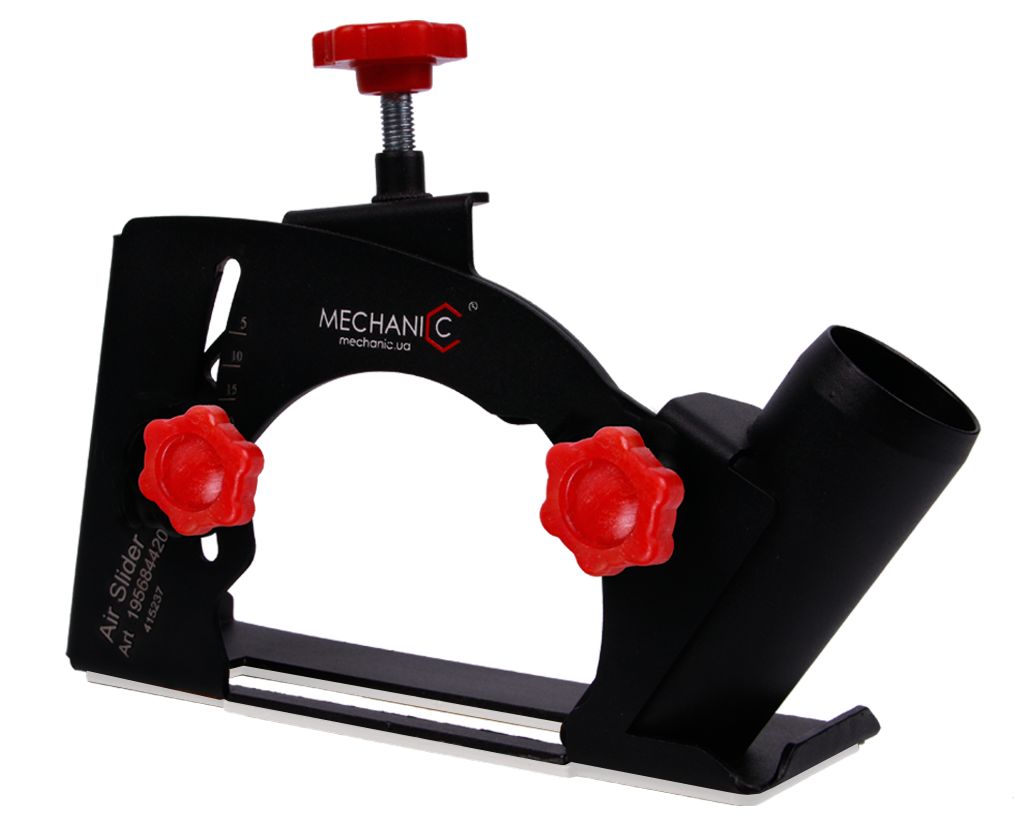Finishing cutting of porcelain stoneware without a tile cutter.

Almost any modern interior design based on ceramic tiles is impossible to achieve without cutting the tiles. Have you ever thought about the quality of the tile edge after cutting it with a tile cutter or an angle grinder?
What determines a cleaner cut, and what tricks do tilers use to achieve the cleanest possible edge? A clean cut can be described as a straight line without visible chips or bends.
It is used in visible areas where the cut cannot be hidden by moldings, baseboards, corners, or other decorative elements.
Many questions arise not only for beginner tilers but even for experienced professionals when it comes to tile processing. In this article, we will try to answer most of them.
What equipment is used for cutting porcelain stoneware?
Today, three main types of equipment are commonly used for cutting porcelain stoneware:
-
Manual tile cutter
-
Electric tile cutter
-
Angle grinder (AG)
Let’s take a closer look at each of these tools.
Manual Tile Cutter
This tool consists of a base with rail guides along which a cutting wheel moves. Cutting is done by scoring the material, followed by snapping it — the process is similar to cutting glass.
The manual tile cutter is designed exclusively for making straight cuts.
Electric Tile Cutter
Unlike the manual version, the electric tile cutter requires a power source and a consumable diamond blade. However, it can handle thicker materials and is equipped with a convenient work table. Water cooling is used to cool the blade during operation.
With this type of tile cutter, you can perform both straight cuts and 45-degree angle cuts.

Angle Grinder (AG)
The most affordable and compact tool for cutting porcelain stoneware is the angle grinder. Unlike tile cutters, the angle grinder allows you to make curved cuts, but it requires a certain level of skill and experience.

Each of these tools has its own advantages and disadvantages, which we would like to highlight.
| Equipment | Advantages | Disadvantages |
|---|---|---|
| Manual Tile Cutter | Affordable price, clean cut, speed, no dust or water, quiet operation. | Only straight cuts, limited to thin materials. |
| Electric Tile Cutter | Clean cuts, 45-degree angle cutting, ergonomic design. | Higher price, requires water supply, noisy, messy, heavy, and bulky. |
| Angle Grinder (AG) | Affordable price, ability to make curved and 45-degree cuts, portability, suitable for additional porcelain operations like drilling and beveling. | High chipping, noisy, produces a lot of dust. |
Now that we have a basic understanding of the main equipment used for cutting porcelain stoneware, it’s worth exploring the types of porcelain stoneware and what can affect its processing.
Types of Porcelain Stoneware and Its Coatings
Today, there is a wide variety of porcelain stoneware available to suit any customer’s needs. Depending on the application area, you can find tiles designed for both interior and exterior use. However, few people consider what affects the material's workability until they face the challenge themselves.
One of the most significant factors influencing the ease of processing is the tile’s surface coating. Porcelain stoneware coatings can be roughly divided into three groups:
1. Without Coating or Relief
Smooth matte and semi-matte surfaces are the easiest to work with. Cutting this type of material results in the least amount of surface chipping.
2. Without Coating but with Relief
For this type of porcelain stoneware, an angle grinder or electric tile cutter is recommended. Using a manual tile cutter may cause the tool to veer off the cutting line. Processing such surfaces is more complicated than the previous type, and chips on the tile surface are more noticeable.
3. Glazed Coating
This glass-like coating varies in fragility, which can lead to moderate or heavy chipping during cutting. This type of porcelain stoneware is the most challenging to process.
Tile Size
Another crucial factor in processing porcelain stoneware is its size. Both the length and thickness of the tile significantly affect the cutting process. Based on its dimensions, porcelain stoneware is divided into three subgroups:
-
Small Format — up to 60x60 cm
-
Medium Format — up to 90x120 cm
-
Large Format — over 90x120 cm
Small format tiles
They are the easiest to transport and process.
Medium format tiles
Processing medium format porcelain stoneware requires additional support systems, such as consoles or tables. This format is often denser and stronger than small tiles, making cutting more difficult.
Large format tiles
Working with large formats presents challenges in transportation, cutting, and installation. For manufacturing large-format tiles, reinforced porcelain stoneware is used, making it even harder to cut.
When performing long cuts, especially with electric tile cutters rather than manual ones, there is a significant load on both the motor and the diamond tool. Therefore, it is crucial to carefully choose both the motor and the consumables because the cost of error is very high.
Just one porcelain tile measuring 5–6 square meters can cost several thousand euros!
Thickness
In addition to size, the thickness of porcelain stoneware also affects how easily it can be processed.
-
For interiors, tiles with a thickness of 6–10 mm are most commonly used, and less frequently 10–14 mm.
-
For exteriors, porcelain stoneware 16–20 mm thick is often used.
Such thick tiles are significantly harder to process and require a specialized blade. Cutting this thickness with a manual tile cutter is impossible.
Choosing the Right Angle Grinder (AG) for a Clean Cut
Out of the three types of equipment used for tile cutting, the most versatile and affordable is the angle grinder. However, selecting the right tool requires careful consideration. Here are the key parameters to pay attention to when choosing an angle grinder for cutting porcelain stoneware:
Power
Angle grinders vary greatly in power — from 0.5 kW to 1.8 kW.
For cutting thick and dense porcelain tiles, it’s better to have extra power reserve and choose a model with more than 1.5 kW.
RPM (Revolutions Per Minute)
Experience shows that maximum RPM ensures cleaner cuts with fewer chips.
For 125 mm grinders, the optimal range is 11,000–12,000 RPM.
It’s worth noting that many models on the market feature variable speed control — a highly useful function for other porcelain processing tasks such as drilling holes and beveling at 45 degrees.
Power Supply
Angle grinders are available in both corded and battery-powered versions.
For porcelain stoneware, a corded model is the better choice due to its higher power output and higher RPM compared to battery-powered tools.
Disc Diameter
Angle grinders typically come in 115 mm and 125 mm diameters, with 125 mm being the most common.
Finding consumables is much easier for the 125 mm size.
At the same RPM, a 125 mm disc reaches a linear speed of about 76 m/s, while a 115 mm disc runs at around 70 m/s.
The higher the linear speed, the fewer chips appear on the tile — and a 10% difference can be very noticeable on certain materials!
Recommended Specs for Porcelain Stoneware
Based on all these factors, the ideal angle grinder for porcelain tile processing is:
-
125 mm disc diameter
-
Power output of 1.5–1.8 kW
-
11,000–12,000 RPM
-
Variable speed control
Once you've chosen the right tool, the next step is selecting the proper consumables.
Blades for Clean Cuts at 45° and 90°
When it comes to cut quality, there are often heated debates among tilers. Most professionals tend to recommend only the blades they’re used to and are reluctant to try something new. However, those who have tried the Distar Esthete blade once rarely switch to anything else.
The key advantage of this blade is its 1.1 mm diamond-bearing layer and 0.8 mm core thickness. Thanks to this ultra-thin layer and fine diamond grain, the blade produces minimal chipping while placing almost no load on the angle grinder’s motor.
The Esthete blade is designed exclusively for straight 90° cuts. You can learn more about working with this blade in the training video:
👉 https://www.youtube.com/watch?v=2XhTGeHCAMs&t=69s
If you need a clean 45° cut, the best choice is the Edge Dry blade. Cutting at a 45° angle is significantly different from straight cutting because:
-
the blade cuts through a larger surface area, and
-
the angle grinder’s motor is subjected to higher stress.
For this reason, Edge Dry features a reinforced 1.2 mm core and an increased 25 mm diamond-bearing layer height, perfectly suited for the task.
Every tiler should have multiple blades in their toolkit for different jobs. However, besides the blades, there are also special accessories that can greatly simplify the tiler’s work.
Mechanic Accessories
Under the Mechanic brand, Distar produces a range of devices designed to make cutting porcelain stoneware easier. Most of these accessories are equipped with a special nozzle for connecting a vacuum cleaner to collect dust during operation.
For clean and precise cutting of porcelain stoneware, the AirSlider 90 is commonly used.

No matter how experienced the tiler is, when cutting by hand, they may unintentionally tilt the tool and the blade to one side, causing additional chipping — especially noticeable during long cuts.
The AirSlider helps maintain a perfect 90° angle throughout the cut. Thanks to its special coating, it glides smoothly over the tile without scratching the surface. Additionally, it features depth adjustment for the blade and a dust extraction port for connecting a vacuum cleaner.
If you need to achieve a clean 45° cut, you should get the Slider 45 device.
_13_11zon.webp)
Similarly to the AirSlider, the Slider 45 features plastic guides that provide excellent gliding over the material. Once properly adjusted, the Slider 45 ensures a clean 45° cut and perfect edge consistency every time.
A special dust extraction pipe (Pipe) is not included in the basic kit but can be purchased separately.
Another useful product from Mechanic worth mentioning is the Abrasive. While not an accessory, it is a consumable material.
The Abrasive is used for sharpening diamond blades, as processing very dense and hard porcelain stoneware can wear down the diamond surface, reducing the blade’s cutting ability.

As we can see, an angle grinder alone — a compact and affordable tool — is enough for clean porcelain stoneware processing.
To achieve the cleanest possible cut, it’s essential to have a powerful angle grinder and several blades suited for different tasks and materials.
Additionally, it is highly recommended to use special accessories for greater comfort and convenience during work.
Remember — a well-equipped tiler can perform various tasks quickly and efficiently while achieving the cleanest possible cuts.







